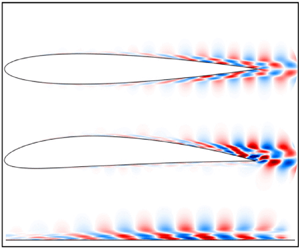Crossref Citations
This article has been cited by the following publications. This list is generated based on data provided by
Crossref.
Vinuesa, Ricardo
Lehmkuhl, Oriol
Lozano-Durán, Adrian
and
Rabault, Jean
2022.
Flow Control in Wings and Discovery of Novel Approaches via Deep Reinforcement Learning.
Fluids,
Vol. 7,
Issue. 2,
p.
62.
Wang, Ruiqin
He, Xiao
and
Yan, Xin
2022.
Spectral proper orthogonal decomposition analysis of trailing edge cutback film cooling flow.
Physics of Fluids,
Vol. 34,
Issue. 10,
Blanco, Diego C.P.
Martini, Eduardo
Sasaki, Kenzo
and
Cavalieri, André V.G.
2022.
Improved convergence of the spectral proper orthogonal decomposition through time shifting.
Journal of Fluid Mechanics,
Vol. 950,
Issue. ,
Massaro, D.
Peplinski, A.
and
Schlatter, P.
2023.
The flow around a stepped cylinder with turbulent wake and stable shear layer.
Journal of Fluid Mechanics,
Vol. 977,
Issue. ,
Demange, Simon
Jekosch, Simon
Church, Benjamin
Sarradj, Ennes
Oberleithner, Kilian
and
Cavalieri, André V.
2023.
Experimental investigation of tonal and broadband trailing-edge noise for the flow around a NACA0012 profile with rounded trailing edge.
Fava, T. C. L.
Lobo, B. A.
Nogueira, P. A. S.
Schaffarczyk, A. P.
Breuer, M.
Henningson, D. S.
and
Hanifi, A.
2023.
Numerical study of the hydrodynamic stability of a wind-turbine airfoil with a laminar separation bubble under free-stream turbulence.
Physics of Fluids,
Vol. 35,
Issue. 8,
Kaiser, Thomas L.
Demange, Simon
Müller, Jens S.
Knechtel, Sophie
and
Oberleithner, Kilian
2023.
FELiCS: A Versatile Linearized Solver Addressing Dynamics in Multi-Physics Flows.
Le Clainche, Soledad
Ferrer, Esteban
Gibson, Sam
Cross, Elisabeth
Parente, Alessandro
and
Vinuesa, Ricardo
2023.
Improving aircraft performance using machine learning: A review.
Aerospace Science and Technology,
Vol. 138,
Issue. ,
p.
108354.
Chiu, Te-Yao
Tseng, Chien-Chou
Chang, Chien-Cheng
and
Chou, Yi-Ju
2023.
Vorticity forces of coherent structures on the NACA0012 aerofoil.
Journal of Fluid Mechanics,
Vol. 974,
Issue. ,
Yin, Haonan
Zhao, Hanqing
Li, Yiping
Zhao, Jie
and
Zhang, Kai
2024.
Airfoil Design and Flow Analysis of a Multi-Blade Centrifugal Fan: An Experimental and Simulation Study.
Applied Sciences,
Vol. 14,
Issue. 23,
p.
11229.
Demange, Simon
Yuan, Zhenyang
Cavalieri, André
Hanifi, Ardeshir
and
Oberleithner, Kilian
2024.
Wavepackets Driving Trailing Edge Noise. Part II – Resolvent-Based Model.
Shi, Xuan
and
Sullivan, Pierre E.
2024.
Plasma Actuator Separation Control Investigated with Spectral Proper Orthogonal Decomposition.
AIAA Journal,
Vol. 62,
Issue. 5,
p.
1755.
Yuan, Zhenyang
Demange, Simon
Jekosch, Simon
Sarradj, Ennes
Oberleithner, Kilian
Cavalieri, André
and
Hanifi, Ardeshir
2024.
Wavepackets Driving Trailing Edge Noise. Part I – Direct Simulation and Experiments.
Cura, C.
Hanifi, A.
Cavalieri, A.V.G.
and
Weiss, J.
2024.
On the low-frequency dynamics of turbulent separation bubbles.
Journal of Fluid Mechanics,
Vol. 991,
Issue. ,
do Amaral, Filipe R.
and
Cavalieri, André V. G.
2024.
Coherent pressure structures in turbulent channel flow.
Physical Review Fluids,
Vol. 9,
Issue. 7,
Müller, J.S.
von Saldern, J.G.R.
Kaiser, T.L.
and
Oberleithner, K.
2024.
Linear amplification of inertial-wave-driven swirl fluctuations in turbulent swirling pipe flows: a resolvent analysis approach.
Journal of Fluid Mechanics,
Vol. 1000,
Issue. ,
Zhu, Wenkai
Chen, Xianliang
and
Fu, Lin
2024.
Resolvent analyses of incompressible turbulent channel, pipe and boundary-layer flows.
International Journal of Heat and Fluid Flow,
Vol. 106,
Issue. ,
p.
109331.
Li, Xiao-Bai
Demange, Simon
Chen, Guang
Wang, Jia-Bin
Liang, Xi-Feng
Schmidt, Oliver T.
and
Oberleithner, Kilian
2024.
Linear stability and spectral modal decomposition of three-dimensional turbulent wake flow of a generic high-speed train.
Journal of Fluid Mechanics,
Vol. 1000,
Issue. ,
Pozuelo, R.
Cavalieri, A.
Schlatter, P.
and
Vinuesa, R.
2024.
Widest scales in turbulent channels.
Physics of Fluids,
Vol. 36,
Issue. 2,
Demange, S.
Yuan, Z.
Jekosch, S.
Hanifi, A.
Cavalieri, A. V. G.
Sarradj, E.
Kaiser, T. L.
and
Oberleithner, K.
2024.
Resolvent model for aeroacoustics of trailing edge noise.
Theoretical and Computational Fluid Dynamics,
Vol. 38,
Issue. 2,
p.
163.



